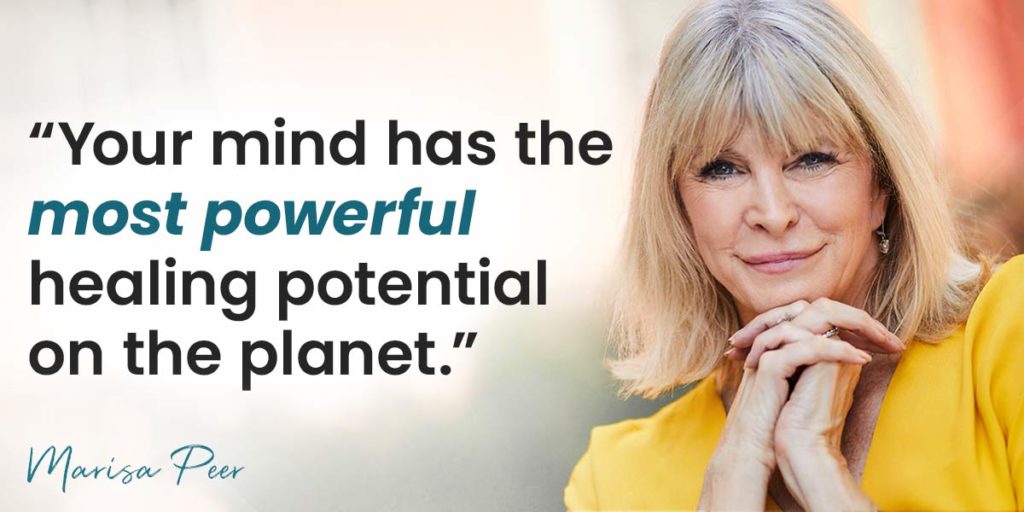Self-healing is like a superpower. It allows you to find more joy in your life, experience less stress, and overcome physical or emotional pain.
Self-healing isn’t as mysterious as you may think. In fact, it can be a fairly quick and uncomplicated process. It also empowers you to take back control of your life.
In this article, we will explore:
- What self-healing is exactly
- How self-healing works
- The four secrets to self-healing and how to use them for greater wellbeing
So, let’s explore how you can create a better life for yourself. What steps can you take to start your self-healing journey today?
What Is Self-Healing?
Self-healing refers to your body and mind’s innate ability to heal itself, guided directly by you. It is a process of using different tools and techniques to support your body and mind in functioning in the most optimal way.
Healing means becoming a better, happier, healthier, and more whole version of yourself. Being able to perform healing yourself puts you back in control of your life. It allows you to grow physically, emotionally, mentally, and spiritually.
Most of us experience these innate healing capabilities every day.
You get a paper cut, and your body quickly heals itself. By the next day or a few days down the road, you barely notice the cut on your finger. The body is a brilliant self-healing mechanism. Yet, so is the mind.
In my 30 years as a therapist, I have seen many individuals use the power of their minds to heal themselves and overcome hurdles in their lives.
You may have heard about the “placebo effect.”
A placebo is basically a fake drug that doesn’t have any chemical effects on the body’s physiological processes. Studies have demonstrated, though, that in some cases, the placebo was almost 50% as effective as the actual drug. Our physical body is able to heal just because our mind believes that the placebo is real and working.
Other research has shown how the visualization of relaxing imagery can decrease stress and even lower blood pressure. Further evidence also indicates that meditation can help reduce the symptoms associated with post-traumatic stress disorder. Multiple studies have suggested that hypnosis has the ability to relieve various physical and mental issues.
These are all examples of self-healing and the power of the mind.
How Does Self-Healing Work?

We tell ourselves all kinds of crazy things, such as, “My dad’s gonna kill me if I don’t get an A on my next exam,” or, “I will die if I have to get up on that stage.” We do this all the time.
However, the truth is if you don’t get an A on your exam, your dad won’t actually kill you, and if you get up on that stage, you’re not actually going to die.
That happens because when you focus on negative things, you will feel negative. Your mind believes what you tell it to believe.
As a therapist with more than 30 years of experience, I can tell you that our minds react to our thoughts as fact.
Every time you have a negative thought, you will feel as though these thoughts are true, and you’ll react to them.
If negative thinking goes on for a while, “negative” neural pathways begin to emerge and strengthen in your brain, making you inclined to have even more negative thoughts.
This is why so many of my clients struggle with anxiety, depression, self-esteem issues, and various types of insecurities.
The good news is you can turn things around by learning how to heal yourself.
Whether you go to the doctor to heal an injury or go on vacation to take some needed time off to mentally recharge, everything begins and ends with the state of your mind.
I always tell my clients that words are powerful—and your mind is listening.
Every thought and word you think forms a blueprint that your mind and body work to make your reality.
It’s up to you to decide what you want your mind to focus on. Using the power of your mind, you can slow down or accelerate your healing process.
You can tell yourself, “I am dying,” when your fever reaches 38℃, or you can tell yourself, “I am feeling a bit out of it today; my body needs a little rest.”
What words you use will make a great difference in your outcomes.
Your thoughts influence your feelings, your feelings influence your actions, and your actions define the outcomes of your events. So if you change your thinking, you change everything.
When you reframe the stories you tell yourself and your interpretations of certain events, you are able to see the world through a more empowering lens. You will be able to literally rewire your brain and change its neural pathways, freeing yourself from old ways of thinking that are holding you back.
When you change your thoughts, both your feelings and your actions change as well.
Whether that is financial or relationship stress, needing relief from physical pain, reducing emotional pain, trauma, eliminating destructive habits, or negative thought patterns, self-healing can help you overcome these stresses in your life.
Learning how to heal yourself can have a positive impact on every area of your life.
How To Heal Yourself: The 4 Secrets To Self-Heal

Self-healing follows a very simple process. It involves changing the way you talk to yourself, the thoughts you think, and the stories you tell yourself. There are four ways you can approach self-healing to create the life you want.
1. Change your meaning
Throughout my thirty years working as a therapist, I’ve been fortunate enough to help thousands of individuals: from CEOs and Olympic athletes to Hollywood superstars.
When a new client starts therapy with me, they usually tell me how different events affect their feelings and thoughts. They don’t realize that this is only a belief they hold, and it is a very limiting belief.
The truth is, no event by itself has the power to affect how you think or feel. It is the meaning you attach to that event that impacts how you think and feel about it.
If you say you hate something or that it is going to kill you, your mind and body will come up with ways to avoid it. This can arise through psychosomatic symptoms.
For example, you keep telling yourself that you hate going to the gym. Your mind and body will act on these messages. Your mind may orchestrate a sickness, granting you a week or two off.
If you change the meaning you attach to different events, you will be able to enjoy life more, experience fewer negative emotions, and self-heal.
What if you said you loved going to the gym? What if you focused on going to the gym to improve your health rather than making it about your looks? It all comes down to changing the meaning, which is entirely within your power.
You can accelerate this process further by working with self-hypnosis audios.
Hypnosis induces a deep sense of relaxation, which allows access to your subconscious mind—the deeper part of your mind where all your beliefs of who you are and how the world works lie. It opens your subconscious mind to positive suggestions, allowing you to rewrite the blueprint and meanings you attach to certain events or activities.
You can try one of my pre-recorded self-hypnosis audios and work on one particular issue at a time.
Work with your subconscious mind to heal your body, overcome anxiety or depression, free yourself from fears and phobias, as well as addictions, and so much more. I recommend listening to a self-hypnosis audio at least once a day for 21 days to get the most benefits.
I was able to help thousands of people around the world self-heal multiple issues using the power of their minds, and I can’t wait for you to try my self-hypnosis audios and heal yourself.
2. Make unfamiliar familiar

As humans, we are hard-wired to stick with what we know. We love the familiar. We know that the familiar has got us thus far, so it must be safe. For the most part, we tell ourselves the same stories and thoughts every day. We stick with the familiar, even when it doesn’t serve us any longer.
Through the last 30 years as a therapist, the most common harmful thought I see in my clients is, “I am not enough.” This is a lie that so many of us tell ourselves, day-in and day-out. We repeat it, so we believe it. This thought can be damaging in so many ways. It can lead to anxiety, depression, addictions, and destructive behavior.
Since your mind will always do what you tell it to do, you need to decide what it should focus on.
One practice I teach is making the familiar unfamiliar and unfamiliar familiar. Tell your mind a new narrative, a new story, and make it familiar through repetition.
Each morning when you get up, repeat positive, empowering statements about yourself. If you are unsure of what to say, ask yourself what you would have longed to hear from your mother or father, or even a teacher, growing up.
Maybe this translates into telling yourself, “I’m proud of you,” “You are good,” “I adore you,” or, “You are amazing,” and most importantly, “You are enough.”
It may feel weird at first, but with enough repetition, your mind will take these new thoughts as the truth.
This practice has the reverse effect on your bad habits or thoughts, making them less familiar, meaning you are less likely to revert back to your negative thinking.
If you are unsure how to start this positive affirmation process and change this common limiting belief, try my award winning ‘I Am Enough’ program or sign up for my free ‘I Am Enough’ masterclass to begin your self-healing journey today.
3. Use visualization to heal yourself
Through my years of practice as a therapist, I observed that our minds work according to certain rules.
For example, our mind can only respond to words that create a picture. The more details in this picture, the more powerfully the mind responds to it.
Another rule is that whatever you focus on is what you get more of.
Knowing this information, what do you want your mind to be focused on?
If you want to self-heal, imagine yourself healed. How does it look like? What feelings are involved? What do you see or hear? Close your eyes and create a picture in your mind.
Studies indicate that visualization techniques can help reduce procedural pain after undergoing surgery. Research also shows that visualization involving the use of guided imagery can help decrease anxiety symptoms.
If you are struggling with anxiety and your self-healing involves staying calm during social interactions, picture that.
Imagine you are confident while interacting with others. Imagine they greet you with warmth and kindness. You don’t feel nervous. Instead, you feel self-assured and relaxed. You feel accepted. Engage as many senses as possible through this visualization exercise.
To make this practice easier, record yourself talking about this experience. Listen to this recording each day or each week and see how much you change.
4. Try practicing regular meditation

Modern society fills our minds with stimuli every second of every day. You might work all day on a laptop, only to come home and try to relax while watching a dramatic TV show.
When you rely on external factors, such as having a drink, to calm down after an argument or watching TV to distract yourself when you want to stop thinking about something, you weaken your ability to control your mind’s reactions. You become less able to manage your own thoughts and emotions.
A powerful way to take back control of the power of your mind is by practicing meditation.
Research shows the effectiveness of meditation when it comes to self-healing physical and mental issues.
Meditation allows you to take back control of your thoughts, feelings, and emotions by giving your mind space to reset and rejuvenate.
Contrary to popular belief, meditation is not simply thinking of nothing. Through meditation, you become the observer of your thoughts, which allows you to create space between stimuli and response. This can help you see a more objective perspective and react through thought rather than through subconscious and automatic reactions.
Researchers at Harvard demonstrated how meditation can improve depression by managing anxiety and stress better. Meditation may also help with reducing physical pain.
So, how do you do it?
Set a timer for five minutes.
Sit in a comfortable position. Close your eyes and focus on your breathing.
Notice how you feel and where the breath is: your chest, your nose, or the pit of your stomach?
Count each inhale and exhale. Keep your attention on your breathing the whole time.
When a thought arises, don’t engage with it or chase it. Take notice of it, acknowledge it, and allow it to pass by coming back to the breath and counting again.
It’s important that you don’t judge yourself when a thought distracts you from your meditation practice. Just notice whatever thoughts and feelings are rising and simply start again whenever you get distracted.
In as little as five minutes a day, this practice can have tremendous benefits on building your ability to take charge and be your mind’s own boss. You will slowly but steadily be able to manage how you respond to any situation that presents itself.
This practice allows you to not be reactive to any external factors, such as an argument with a friend or even physical pain. It puts the power back in your hands and allows you to choose and guide yourself on how to respond when such situations present themselves to you.
Stepping Forward Into a Better Life
You are your own healing superpower. The above self-healing techniques can help you create a better life for yourself. I’ve been fortunate enough to help tens of thousands of people overcome great hurdles in their lives through these incredible methods.
If you’re interested in furthering your self-healing journey, feel free to check out my free ‘I Am Enough’ meditation or my free ‘I Am Enough’ masterclass. You can also get the full ‘I Am Enough’ program and a variety of self-healing hypnosis audios. I’m so excited for you to begin your own self-healing journey. I can’t wait to hear how these techniques change your life.




